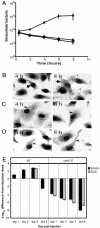Directed antigen delivery as a vaccine strategy for an intracellular bacterial pathogen
- PMID: 16549792
- PMCID: PMC1458801
- DOI: 10.1073/pnas.0509381103
Directed antigen delivery as a vaccine strategy for an intracellular bacterial pathogen
Abstract
We have developed a vaccine strategy for generating an attenuated strain of an intracellular bacterial pathogen that, after uptake by professional antigen-presenting cells, does not replicate intracellularly and is readily killed. However, after degradation of the vaccine strain within the phagolysosome, target antigens are released into the cytosol for endogenous processing and presentation for stimulation of CD8(+) effector T cells. Applying this strategy to the model intracellular pathogen Listeria monocytogenes, we show that an intracellular replication-deficient vaccine strain is cleared rapidly in normal and immunocompromised animals, yet antigen-specific CD8(+) effector T cells are stimulated after immunization. Furthermore, animals immunized with the intracellular replication-deficient vaccine strain are resistant to lethal challenge with a virulent WT strain of L. monocytogenes. These studies suggest a general strategy for developing safe and effective, attenuated intracellular replication-deficient vaccine strains for stimulation of protective immune responses against intracellular bacterial pathogens.
Conflict of interest statement
Conflict of interest statement: No conflicts declared.
Figures




References
Publication types
MeSH terms
Substances
Grants and funding
LinkOut - more resources
Full Text Sources
Other Literature Sources
Molecular Biology Databases
Research Materials

